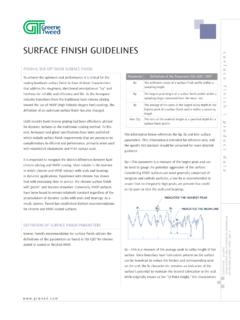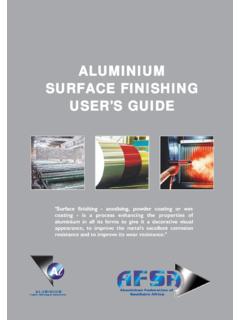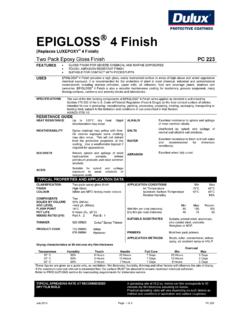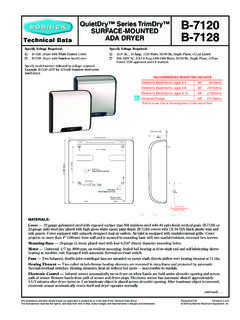Transcription of General Notes and Architectural Guidelines
1 << return to Architectural Guidelines and General Notes Chicken Hill Asheville, NC. prepared by: for residential properties of URVANA, LLC. Architectural STANDARDS. 1. WALLS. Piers and Foundation walls: shall be stone, wood, brick, exposed concrete, concrete block or stucco. Building walls: shall be finished in stone, stucco, wood, brick, exposed concrete, or hardiplank clapboard. There shall be a maximum of two (2) primary building wall materials, excluding windows, doors, accents, and trims. These materials shall be appropriate to the building style/ building type and shall be consistent on all sides of the building.
2 Building materials used to simulate other building materials shall count as separate building materials provided there is a change in texture, color, and pattern of the finish. Columns and posts: shall be stone, wood, brick, exposed concrete, steel, cast iron, or stucco. The spacing between columns or posts shall have a height to width ratio of 1:1, 2:1, 2:3, or 5:1 or another proportion that emphasizes the verticality of the spacing between columns (intercolumniation). There shall be a maximum spacing of twelve feet (12') between columns/piers.
3 Steel, cast iron, or wood columns or posts shall have a minimum of twelve inches (12 ) in width or depth. Garden walls and fences: shall use wood, aluminum pickets, stone, stucco, or landscaped hedges (see below). Gates to garden walls shall be wood or metal. Retaining walls: shall use stone, brick, poured concrete or stucco. Hedges: landscape hedges along the public right-of-way shall not exceed three feet (3'); landscape hedges on the required setbacks, on the lot sides, and the lot rear shall not exceed six feet (6') in height.
4 2. ATTACHMENTS. Porches: shall be wood, exposed pre-cast concrete, fiberglass, or steel. They shall be no less than 6 ft. in depth. Porches may be enclosed with screens only. Awnings: shall have a metallic armature covered with a canvas membrane. Awnings shall be sloping rectangles without bottom soffit panels. Awnings shall not be internally backlit. Balconies and railings: shall be made of wood, cast iron, or aluminum. Balconies that cantilever shall be structurally supported by brackets. Decks: shall be located in rear yards only, and painted or stained except walking surfaces which may be unpainted.
5 Decks shall be wood or exposed concrete. Loggias: shall occupy no more than 80% of the building frontage (loggias shall occur on the upper floors of any building). Stoops: shall be made of wood, stone, or exposed concrete. Trellises: shall be wood or metal. Spacing between columns or posts shall emphasize the vertical proportions (see: columns and posts). Yard equipment: including HVAC, utility meters, clotheslines, cisterns, satellite dishes, play equipment, hot tubs, shall not be permitted at building frontages and shall be screened from public view with hedges or garden walls.
6 3. ROOFS. Dormers: shall be habitable and operable and shall have gable, shed or hipped roofs. Eaves and rafter tails: eaves shall be continuous. Exposed rafters are encouraged. The tip of any rafter tail shall not exceed 6 in. in depth. Flat roofs: No flat roofs. Gutters and downspouts: Roof eaves shall be guttered to promote a pedestrian friendly environment. Gutters must be built of durable materials and integrated into the Architectural design of the building. Skylights: shall be flat mounted only on the rear slope of the roof.
7 Sloped roofs: shall be clad in slate, wood shingles, or galvanized metal roofs, which should be either 5-V crimp or corrugated metal with a galvanized finish or painted dark green, barn red or burnished slate or another approved color. Roof penetrations shall not occur on the front slope of the roof. Splash blocks: shall be stone, gravel, concrete, or brick. Vents and attic ventilators: shall be painted to match the color of the roof except with those made out of metal which may be left natural. 4. OPENINGS. Blank walls: where blank walls are unavoidable, due to the requirements of a particular land use or structural needs, they shall not exceed a length of twenty- five feet (25'), or twenty percent (20%) of the length of the building facing the street, whichever is less.
8 Blank walls shall be treated with trellises or built-in benches in front of the walls, with climbing vines, or with other planting materials covering at least 30% of the blank wall surface. Doors: shall be made of painted wood, embossed steel or fiber-glass with wood veneer. Glass: shall be clear. Garage doors: shall have a maximum of 9 ft. in width. Lintels and sills: should generally align along the fa ade. Window sills shall receive more emphasis than window lintels to produce a stronger shadow line. The window sill should extend no more than 2 in.
9 Beyond the window and any surrounding trim. Screens: shall cover the exact openings. Screens may cover a porch area from roof to ceiling. Shutters: shall be made of wood, copper, aluminum or any other durable metal. Shutters must be operable and shall cover entire window area. Shutters shall be either louvered or paneled. Storefronts: shall be made of wood or metal. Window frames: shall be made of wood, metal, or vinyl and shall be glazed with clear glass. Storm windows, shutters, and screens, if provided, shall be operable and cover entire window area.
10 Window louvers: shall be made of wood, metal, or any other durable material. 5. General Notes : Railings: shall have horizontal top and bottom rails centered on the spindles or balusters. The openings between spindles and blusters shall not exceed 4 inches. Baluster ends shall terminate into the railing tops and bottoms and not be attached to their face. Street lighting: street lights shall be simple rather than ornate and their placement shall not obstruct storefronts. A down light or cut-off lens, with no glare, shall be used whenever possible.








